Schmaltzie goes to war: P-47 Thunderbolt, 57th FG ,65th FS
The original
With its distinctive appearance, the P-47 Thunderbolt is one of the best known aircraft of the Second World War. The recognition value of a P-47 is indeed high; it is determined by a technical design to which the superior flight performance of the Thunderbolt can be traced.While the bulky nose can be quickly attributed to the installation of the well-known Pratt & Whitney R-2800 engine, the real secret of the P-47 lies behind the bulky underside of the fuselage and the unusual design as a mid-wing aircraft.
An exhaust-driven turbocharger installed underneath the wing spars supplied the enormous R-2800 with sufficient boost pressure even at high altitudes; the hot exhaust gases ejected at the rear lower fuselage section also turned the Thunderbolt into half a jet. The flight performance is correspondingly impressive. While the D-version in its numerous sub-variants already reached speeds of 690 km/h, the later M- and N-variants even reached speeds of over 750 km/h, each measured at an altitude of over 9000 metres.
The exhaust gas turbo gave the Thunderbolt excellent performance at high altitudes and would have predestined it for escort missions. However, the experience of the first months of operation in Europe showed that the P-47 lacked the range for missions deep into the continent. Instead, practice revealed another "talent".
As a fighter, the Thunderbolt was successful wherever it could exploit its high speed. Roll rate and manoeuvrability, on the other hand, were not its strong points; here, opponents such as the Bf 109 or Fw 190 proved superior. The ability to carry up to a ton of weapons to the enemy, in addition to an impressive armament of eight 12.7mm calibre machine guns, gave the aircraft a new role as a ground attack aircraft. In the second half of the war, as the front lines moved ever closer to Nazi Germany from all directions, the P-47 was preferred in this role. This is also shown quite well in the history of the unit to which the prototype of my model belonged.
Founded in 1941, the 57th FG and its squadrons, which included the 65th FS "Fighting Cocks", moved to Africa in July 1942. There the squadron participated intensively in the battles in North Africa and over the Mediterranean, and was also involved in the battles around El Alamein and in the Allied landing on Sicily.
Until then the units flew P-40s, but from 1944 they were converted to P-47 Thunderbolts. Afterwards, the 65th FS was transferred to Corsica. From the Alto base, the pilots flew daily combat missions, which were to lead them, following the course of the front, mainly to central and northern Italy. From Corsica, the group's P-47s also supported the major landing operations to conquer southern France. In early 1945, they were transferred to Grosseto, Italy, from where they flew deep attack missions towards northern Italy, the Brenner Pass and into Austria until the end of the war.
My model shows a P-47D of the 65th FS flown by Francis J. Middleton as it was deployed from Alto and later from Grosseto. The squadron emblem of the 65th, the "fighting cock", is emblazoned on the engine cowling, as on all aircraft of the unit. What makes this Thunderbolt truly unique, however, is its double designation as "Schmaltzie" and "Mercedes". Although it would be interesting to know who the names refer to and how this came about, I was unfortunately unable to find out.
About the model
The decals for this attractive and interesting aircraft come from the Kagero publication "SMI Library 07: Thunderbolt in the USAAF MTO, Asia and Pacific". For the project itself I used the for good reason quite well known and really extremely comfortable to build kit from Tamiya.
More or less built out of the box, only the harness and the instrument panel were completed with Eduard scratched parts. In my zeal I had also acquired a set of brass MG barrels in preparation for the project. However, a timely look at the corresponding kit parts would have prevented this. These are of delicate fineness and precision and would therefore have been quite sufficient to represent the hollow barrels.
The build itself, as already indicated, was comfortable, problem-free and reasonably speedy, so that I was soon able to get down to the colouring. I may point out the combination of painted yellow areas with black decal stripes depicted borders. This worked excellently, I can only recommend this approach for similar tasks. The metal surfaces of the P-47 were represented with different metal tones of Alclad. The finished NMF surfaces were then sealed with acrylic clearcoat from Gunze, which, as usual, worked very well as a primer for applying the decals. "Washing" and ageing were largely done with pastel chalk.
I really enjoyed the build and it did me good, because after a few rather challenging projects such a comfortable kit brought enough joy and motivation for further things. Speaking of "what's next": right after completion another Tamiya Thunderbolt found its way into my kit storage - the Tamiya P-47 has really taken my fancy!
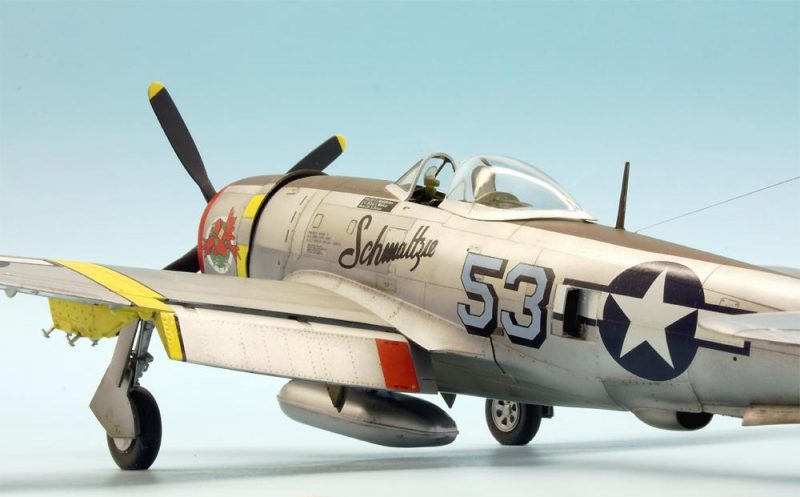
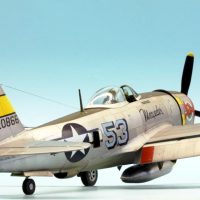

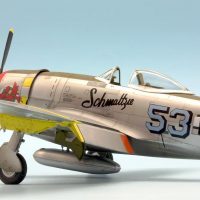
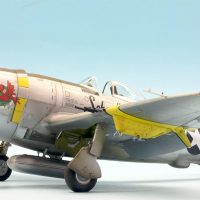
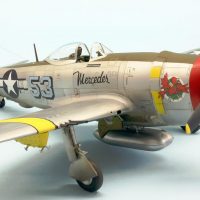
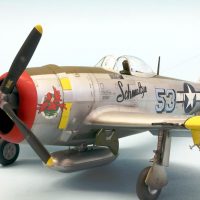
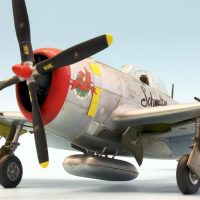
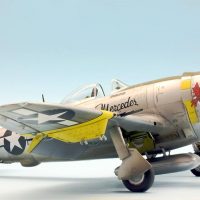


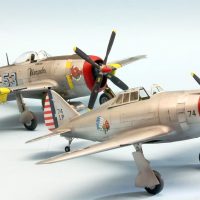
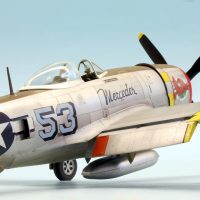
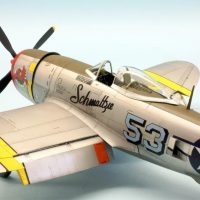
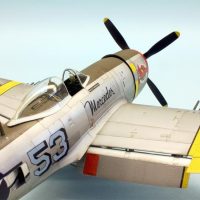
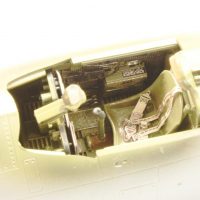

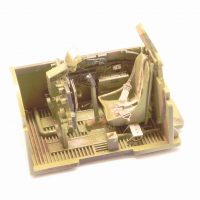
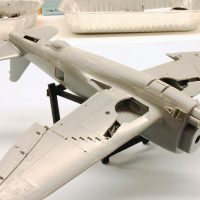
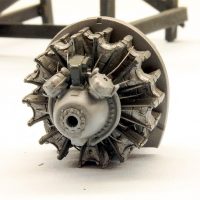
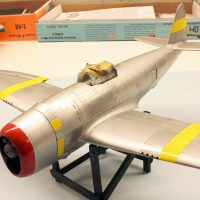
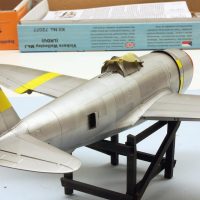
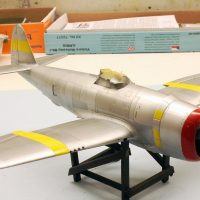
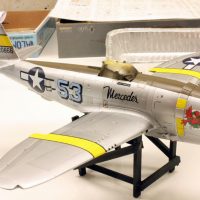
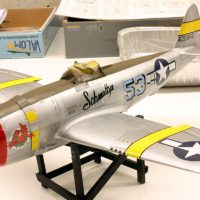
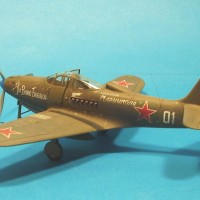
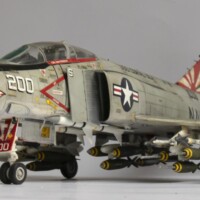
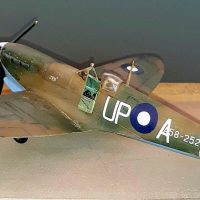
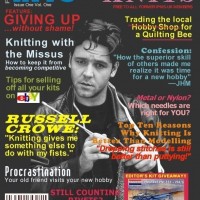
Beautiful model Roland, unlike the decal option also. One just can’t go wrong with this kit, one of the best Tamyia made. Great work!
Roland, excellent use of NMF shading in combination with the washes and pastels. What really allows you to get away with this is the photography. The close ups and the forced perspectives, lighting, and the clarity of the subject are the envy of the majority of modelers. Professional is a good word.
Loved the article too. Two thumbs up.
Very well done, Roland.
The NMF is fantastic, especially those different tones.
Thank you very much, Pedro, Stephen, John! Your comments are more than just motivating! Stephen, your comment on image quality are a pleasure, thank you!
Great finish
Great looking Jug!
Really nice, Roland. I like it a lot and hit "liked"
The name "Mercedes," being on the right side, was for the crew chief (generally) and could likely have been a mother, wife or girlfriend. "Schmaltzie" was from the pilot.
The 57th, which was the first USAAF unit in the European theater, arrived by way of USS Ranger (CV-4) which flew them off at Accra, from which they then flew across equatorial Africa, then up the Nile Valley to Egypt, where they flew with the RAF's Desert Air Force in North Africa, arriving there in time to be reinforcement for El Alamein.
The unit had a very interesting personnel structure: pilots began as "Sprogs;" after proving themselves over 10-15 missions, they became "Sports;" after demonstrating competence over 25-30 missions, they became "Old Sports," and if they rose to any command position, they were "Wheels." Rank on the ground did not apply in the air; leadership positions were given by demonstrated ability, and it was not unknown for a Major to remain a "Sport" his entire tour, flying in formations that might be led by a 1st or 2nd Lieutenant. Losses were such in the ground attack role that Michael McCarthy, who arrived in the 65th squadron a month before he turned 19 just after the Easter Sunday Massacre in April 1943 and flew an amazing two tours to the end of the war, was promoted to Major as deputy squadron ops officer two months before he turned 21. He later wrote that "my unit went through 400% losses in the two years I flew with them." The loss rate was what determined promotion from Sprog to Sport (if you survived those first 10-12 missions) and from Sport to Old Sport (again, if you survived).
The 57th has a website with a lot of history and many first-person accounts from people no longer with us. Over the course of the war, they flew more missions than any other USAAF group (getting in early), and were the top-scoring group in both air and ground in the 12th AF in Italy.
Tom, thank you very much for your comments. Your descriptive text gives it all welcome background and life! i appreciate you putting your profound knowledge and experience into the comments. This story is worth knowing. Thank you!
Roland...beautiful, impressive model but the photos, WOW! They really stand out. Nice job!
Always love a jug and that is one nice jug.
Roland, This is a beauty !
As a big fan of the P-47 and the Tamiya kit (probably my favorite kits of all time), this is a real win for me.
Gorgeous Jug inside and out! A very unique scheme, and wonderful execution!
Awesome job on this T-Bolt. TY for including the shots of the cockpit and the "brother" photo with the P-43. Liked.
That’s hands down one of the nicest jugs I’ve ever seen. Well done!
Jim
Very attractive colour scheme and a very nice job on this Thunderbolt. Superb looking NMF.
Roland, this is another one of your wonderful builds in all terms, especially in painting and decalling and I fully echo all above gents praises.
Great supporting story, too!
Excellent work Roland, that's an exceptionally good looking Jug.
Super-duper job on this beloved classic kit. All good.
I echo the comments made above... Very nicely done. One of the best I have ever seen. I pressed the "liked" button too. 🙂
Your comments make me really happy and actually a little proud 🙂 I appreciate being reviewed by you in such an appreciative way; thank you all for these wonderful reactions and your interest!
A real beauty! One of the things I like best about the P-47 as a subject is that it wore so many interesting schemes - it is such a big canvas!